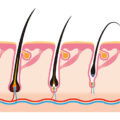Last updated on July 2, 2024
Early diagnosis of female pattern hair loss can be difficult because hair loss in women can be caused by many other factors, such as illness or hormonal changes. Hereditary pattern hair loss, or androgenic alopecia, is less common in women than in men.
For this reason, a doctor or hair restoration specialist will ask for medical history, any possible contributing factors, including pregnancies or onset of menopause and order a set of blood tests.
The blood tests will include a full blood count (FBC), iron (Se Ferritin), thyroid-stimulating hormone (TSH), blood sugar level (BSL), follicle-stimulating hormone (FSH), estradiol (E2) and erythrocyte sedimentation rate (ESR), a non-specific screening for various diseases. The results of these tests will allow your doctor or hair restoration specialist to determine if the hair loss could be due to nutritional, hormonal or stress factors.
The doctor will also ask how long the hair loss has been occurring and whether other women in the family have a similar loss. Whether the hair is breaking or falling out at the roots and if the hair loss is patchy or generalised thinning across the scalp can also help diagnose the cause.
Female hair loss in patches can be due to alopecia areata, which affects around 2% of women. The exact cause of this is unknown, but it is thought to be hereditary or an auto-immune condition.
If excessive hair comes away during brushing, this could be due to loose anagen syndrome, in which healthy, growing hairs are not held firmly in the follicles and are easily combed out. This condition is most often seen in blonde-haired children.
Shedding over the entire scalp is a condition called telogen effluvium. In this, an excessive number of hairs are shed simultaneously. This can be a long term chronic condition or sometimes acute.
A stressful event such as high fever, a severe dietary deficiency or severe blood loss can cause acute diffuse shedding.
Hair can also be pulled out if the hair is usually worn in tight braids or a tight ponytail. The continual tension pulling on the hair leads to traction alopecia, where the hair is permanently lost from the affected follicles.
If someone compulsively pulls or plucks their hair, this can lead to irregular bald patches. This condition is called trichotillomania. The compulsive behaviour may be entirely unconscious but can still lead to permanent hair loss.
Irregular bald patches can also result from scarring from wounds or burns or medical treatment such as chemotherapy or radiotherapy.
A crash diet or chronic protein deficiency can lead to hair loss, as can menopause and some oral contraceptives.
Abnormalities in thyroid function can contribute to hair loss, as can some illnesses, stress or a major operation.
Pregnancy leads to hormonal changes, which can increase hair growth. When the body returns to normal after childbirth, sudden loss of the extra hair may give the impression of excessive hair loss.
Hair loss treatment will depend primarily on the cause and must be discussed with a doctor or hair restoration specialist.
If you are concerned about hair loss, call 1800 021 021 to book a consultation.








